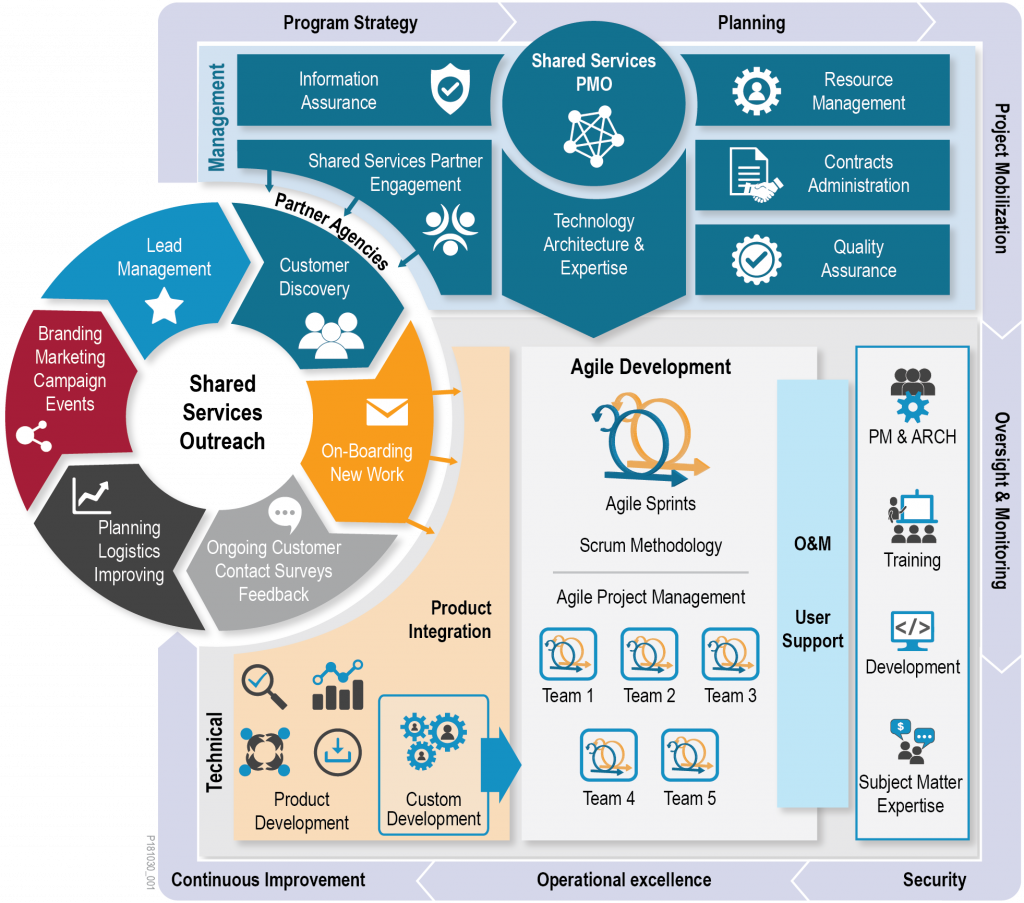At 25 years old, we tend to think we know everything in the universe. While our younger selves might have been mistaken, TCG’s 25 years of supporting multiple federal shared services have certainly taught us a thing or two. The Shared Services Management Model (SSMM) is our way of delivering these lessons to new customers and challenges.
Historically, the lack of working capital funds (WCF) has inhibited multi-year capital investments and contracting. Agencies have responded by minimizing attention on the broadly-felt benefits of shared services in favor of delivery on the core mission — an understandable and important consideration! But this is changing. The Technology Modernization Fund (TMF), urgents needs in broad modernization of Federal IT, and budget realities have turned attention back to sharing capabilities rather than building duplicative and redundant services.
Of course, any agency can claim to provide a shared service by simply having another agency use their system or resources. But, while many shared services have begun this way, a true shared service adopts the needs of others as it’s own — the service’s mission is to serve other agencies. Helping other agencies is not a by-product of the work, it is the whole purpose of the effort.
This demands coherent strategic planning and resources for activities that are non-traditional in government. The SSMM shows how they are successfully integrated in the federal government context.
But what is a “federal shared service?” Some believe that “shared services” are synonymous with enterprise-wide capabilities such as financial management, human resource management, and payroll. This is a narrow view, and ignores the enormous potential for sharing that exists elsewhere, across the government.
In our view, a federal shared service is a set of tools, processes, data, and resources focused on the delivery of specific outcomes or capabilities. They are designed and operated by one federal agency and utilized by other federal agencies and (in some cases) non-federal partners, e.g. state and local governments, and international governments.
Today, government understands that there are hundreds of shared responsibilities, data sets, and capabilities that, if consolidated and shared, can save millions in taxpayer dollars, massively accelerate the mission, and harden the security posture of the government as a whole. These include functions like data collection exercises, emergency preparedness, property inspections, ethics disclosures, and budgeting.
Why are shared services key to the future of government? A few key reasons are clear:
- Centralization of common processes, data, and associated tools builds excellence in one place from which all can benefit.
- Diminishing resources for capital investments mean agencies must pool investments to yield sufficient outcomes to meet the mission.
- Sharing of data and information across agencies improves mission effectiveness, and has critical impacts for purposes such as national security.
- Citizens and government staff demand (and deserve) higher-quality customer service that can only be obtained through shared services

The SSMM provides a framework for agencies to think about and manage these capabilities for their own shared services. The SSMM guides agencies through the shared service resource development process and the activities that need to take place during program strategy, planning, project mobilization, oversight and monitoring, security, operations, and improvement phases. It is derived from TCG’s 25+ years of experience in building and operating federal shared services such as MAX.gov, BFEM.gov, Integrity.gov, NITRC.org, and iEdison.gov. SSMM simplifies the governance of shared services so government executives can address their production, operation, and utilization confidently. The key components of the Shared Services Management Model are:
Shared Services Outreach
- Lead Management
- Customer Discovery
- On-Boarding New Work
- OnGoing Customer Contact Surveys Feedback
- Planning Logistics Improving
- Branding Marketing Campaign Events
Management Support
- Program Management Office (PMO)
- Information Assurance
- Shared Services Partner Engagement
- Technology Architecture & Expertise
- Resource Management
- Contracts Administration
- Quality Assurance
Technical Support
- Product Integration
- Agile Development
- Partnership with Domain Experts
Shared Services Governance Lifecycle
- Program Strategy
- Planning
- Project Mobilization
- Oversight and Monitoring
- Security
- Operational Excellence
- Continuous Improvement
In the next few weeks, we will publish more details about each component of the SSMM, and dig into how agencies can use the model to define, design, operate, and maintain successful federal shared services.
In the meantime, read more about shared service that your agency can utilize today.